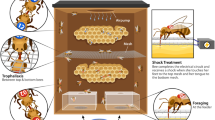Abstract
Dancing and trophallactic behaviour of forager honey bees, Apis mellifera ligustica >Spinola, that returned from an automatic feeder with a regulated flow rate of 50% weight-to-weight sucrose solution (range: 0.76–7.65 μl/min) were studied in an observation hive. Behavioural parameters of dancing, such as probability, duration and dance tempo, increased with the nectar flow rate, though with very different response curves among bees. For trophallaxis (i.e. mouth-to-mouth exchange of food), the frequency of giving-contacts and the transfer rate of the nectar increased with the nectar flow rate. After unloading, foragers often approached other nest mates and begged for food before returning to the food source. This behaviour was less frequent at higher nectar flow rates. These results show that the profitability of a food source in terms of nectar flow rate had a quantitative representation in the hive through quantitative changes in trophallactic and dancing behaviour. The role of trophallaxis as a communication channel during recruitment is discussed.
Similar content being viewed by others
Author information
Authors and Affiliations
Additional information
Received: 14 January 1995/Accepted after revision: 14 August 1995
Rights and permissions
About this article
Cite this article
Farina, W. Food-exchange by foragers in the hive – a means of communication among honey bees?. Behav Ecol Sociobiol 38, 59–64 (1996). https://doi.org/10.1007/s002650050217
Issue Date:
DOI: https://doi.org/10.1007/s002650050217




